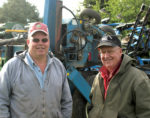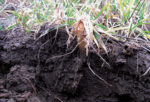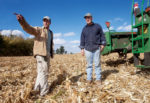Advertise Follow Us
Articles by Clair Urbain
More erratic precipitation patterns and shifting seasons are reinforcing the value of a comprehensive no-till plan for improving soil health.
Read More
Using Precision Tools to Drive No-Till Performance
Whether it’s planting, fertilizing or harvesting, Illinois growers Don and Dave Myers are implementing technology in every facet of their no-till operation to achieve greater yields and returns.
Read More
Build Up Your No-Till Soils and Earthworms Will Come
Reducing tillage, adopting controlled traffic, seeding cover crops and improving drainage can help no-tillers build populations of these nutrient-laden subterranean creatures.
Read More
Turning Back The Clock To Healthier No-Tilled Soils
Alabama’s Blythe Cotton Co. is using no-till rotations, a diverse herbicide program and a focus on precise fertilizer applications to transform their red-clay hilltops into productive soils.
Read More
Making Dollars And ‘Sense’ With No-Till
From spraying to planting to soil sampling, Missouri no-tiller Garrett Riekhof crunches the math on nearly every equipment and precision investment to get the highest possible ‘ROI’ to the bottom line.
Read More
The New Era Of Spray Application
New technologies will help growers fine-tune their spraying applications as next-generation herbicide formulas and herbicide-resistant cropping systems hit the market.
Read More
Cut, Chop, Smooth, Mix: Vertical Tillage Seeks No-Till Role
Some no-tillers and strip-tillers say vertical-tillage tools are helping them size and incorporate residue, prepare seedbeds, reduce weed pressure and improve planting conditions without trashing no-till.
Read More
Fine-Tuning Fertility Makes Strip-Till More Profitable
Using precision technology, Paul and Mike Schweitzer continue to evolve their strip-till and fertilizer systems to slash input costs, preserve soil and water quality and achieve higher yields.
Read More
Switching Hybrids On The Fly Could Boost Corn Yields
Using equipment already available, Beck’s researchers are matching corn hybrids and populations to management zones, netting nearly 20 bushels an acre more in yields.
Read More
Promise Is Showing With Sequential Fungicide Applications
University and onfarm research is finding a one-two punch of fungicides is resulting in healthier plants and higher yields.
Read More















